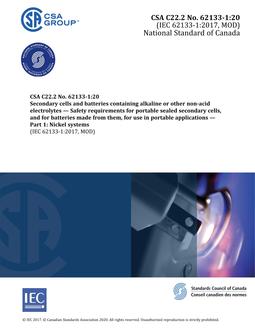Click here to purchase
Preface:
This is the second edition of CSA C22.3 No. 9, Interconnection of distributed energy resources and electricity supply systems. It supersedes the previous edition published in 2008, under the title Interconnection of distributed resources and electricity supply systems. It is one of a series of Standards issued by CSA Group under Part III of the Canadian Electrical Code.
Ongoing changes to electricity supply markets, including deregulation and the introduction of new market participants in the area of electricity generation, have created a need for standardized connection practices for connections to distribution systems operating at 50 kV or below. Prior to 2019, distributed energy resource (DER) interconnection requirements related to product certification and project impact assessment were distributed amongst three CSA Group standards: CSA C22.2 No. 107.1, CAN/CSA-C22.2 No. 257, and CSA C22.3 No. 9. CSA Group has revitalized CSA C22.3 No. 9 to consolidate all the requirements for DER interconnection in a single standard that will be referred to by utilities and system designers for interconnection and manufacturers for DER certification. This standard addresses key requirements for Canadian distributors and can be considered the new standard for interconnecting DER in Canada.
This Standard is intended to address this need by providing technical requirements for the interconnection of distributed energy generation systems and electricity supply systems.
Significant changes in this edition include:
a) Revisions to Clause 6 (distribution system characteristics) regarding abnormal voltage and frequency operating conditions.
b) Revisions to Clause 7 (requirements for the interconnection system) regarding
i) identifying DER grades with specific requirements for each grades based on their capabilities;
ii) reactive power control requirements for DERs at the point of common coupling;
iii) active power control function requirements for DERs;
iv) voltage and frequency disturbance ride-through requirements for DERs; and
v) Intentional islanding protection requirements for DERs.
c) Revisions to Clause 8 (interconnection tests) regarding
i) production and type testing for inverters updated from CSA C22.2 107.1;
ii) test requirements for intentional islanding; and
iii) provisional testing for advanced inverter functionality.
In addition, figures and tables were updated to reflect minimum industry requirements.
This Standard has been developed in compliance with Standards Council of Canada requirements for National Standards of Canada. It has been published as a National Standard of Canada by CSA Group.
Scope
1.1
This Standard specifies the technical requirements for the interconnection of distributed energy resources (DER) and distribution systems up to 50 kV line to line at the point of common coupling (PCC).
1.2
This Standard does not define the maximum DER capacity or the upper voltage limit for installations that are interconnected with a single PCC or connected to a given feeder.
1.3
The objective of this Standard is to specify minimum requirements for the
a) safety of persons;
b) continuity of service; and
c) protection of property.
1.4
This Standard does not apply to secondary network connections and does not address
a) protection of the power producer?s facility;
b) operating requirements for DER units;
c) transmission system impact and upgrades;
d) planning, design, or operation of the distribution system or DER system;
e) metering, rates, tariffs, and other contractual or commercial issues associated with interconnection; or
f) interconnection of distributed energy resources and distribution systems that are not ultimately connected to a province-wide or regional electricity grid (i.e., remote locations).
Note: The wires owner of a remote grid might choose to apply this Standard in part or whole, where appropriate for the remote grid.
1.5
In this Standard, “shall” is used to express a requirement, i.e., a provision that the user is obliged to satisfy in order to comply with the Standard; “should” is used to express a recommendation or that which is advised but not required; “may” is used to express an option or that which is permissible within the limits of the Standard. Notes accompanying clauses do not include requirements or alternative requirements; the purpose of a note accompanying a clause is to separate from the text explanatory or informative material. Notes to tables and figures are considered part of the table or figure and may be written as requirements. Annexes are designated normative (mandatory) or informative (nonmandatory) to define their application.
Product Details
- Edition:
- 1st
- Published:
- 01/01/2020
- ISBN(s):
- 9781488321269
- Number of Pages:
- 41
- File Size:
- 1 file , 960 KB
- Product Code(s):
- 2427067, 2428051, 2427067
